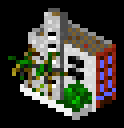Scale
All buildings have floors (stories
if you're old-fashioned). SCURK graphics, on the other hand, are made up
of pixels. So, the first decision to be made when SCURKing a new building
is "How many pixels high will each floor be?". The sky is the limit, of
course (the top of the tile anyhow), but the sizes that seem to work best
are 3-, 4-, and 5-pixel high floors. Of
these, the 4-pixel high scale - which I call "4 scale" - is probably the
most versatile, although there have been some fantastic tiles made in 3
scale.
Much larger than the 3, 4, or 5 scales
and you start to run out of space in which to do a decent-sized building
on a tile - although I have done an occasional 6 scale building when I
needed extra space for detailing. On the other hand, 2 pixels is as small
as you can go. It's hard to do any meaningful detailing at that scale,
but it is great if you want to do a REALLY tall building (Empire State)
- how else are you going to fit that many floors on one tile?. As I said
before, 4 scale is probably the most versatile as it gives a good balance
of available space for detailing versus the overall size of the building
- see my section on windows.
 |
 |
 |
 |
| 3 scale |
4 scale |
5 scale |
6 scale |
To a certain extent, you can mix and
match scales within a tileset and even within a single tile. If you stick
to the 3-4-5 scale range you don't have to great a risk of having buildings
that are obviously out of proportion. I like to put multiple buildings
on a single tile (going for that "downtown", "built-up" look), so I usually
surround a 3 or 5 scale building with 4 scale buildings to blend it into
my tile set. I suppose that you could do the same thing on a single-building
tile by putting 4 scale ground-level details around a 3 or 5 scale building.
Likewise, I suppose that if you work with any three consecutive scales
(i.e. 4-5-6 scales or 5-6-7 scales) you should get proportional looking
results.
 a
mix of 3, 4, and 5 scale
a
mix of 3, 4, and 5 scale
Besides shifting scales between
buildings, you can often get very good results shifting scales in the same
building. Remember, 3 scale is good for fitting a lot of building onto
a tile, while 5 scale is good for detail and 4 is good for both. Often
only the top and bottom of a building has a lot of detail while the middle
is a long row of windows. So, make the middle at 3 scale and the top and/or
bottom at 4 scale! A 4 scale middle with a 5 scale top/bottom also works.
Here is an example, which goes from 5 scale to 4 to 3:
 The most important thing to remember about scale is that
it is not a rule, but rather a guide, a way of measuring
up relative sizes of structures and keeping everything in proportion.
The most important thing to remember about scale is that
it is not a rule, but rather a guide, a way of measuring
up relative sizes of structures and keeping everything in proportion.










 a
mix of 3, 4, and 5 scale
a
mix of 3, 4, and 5 scale


